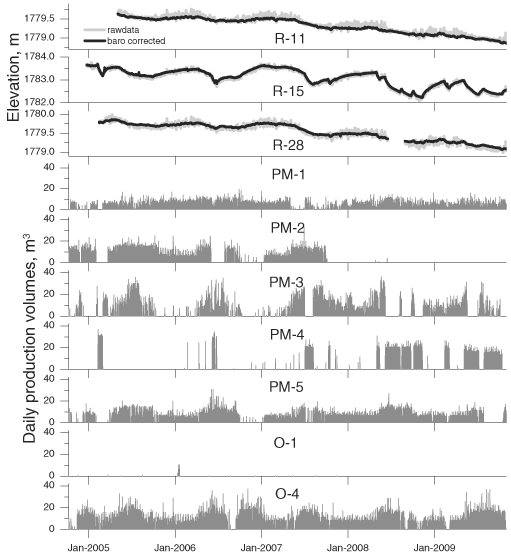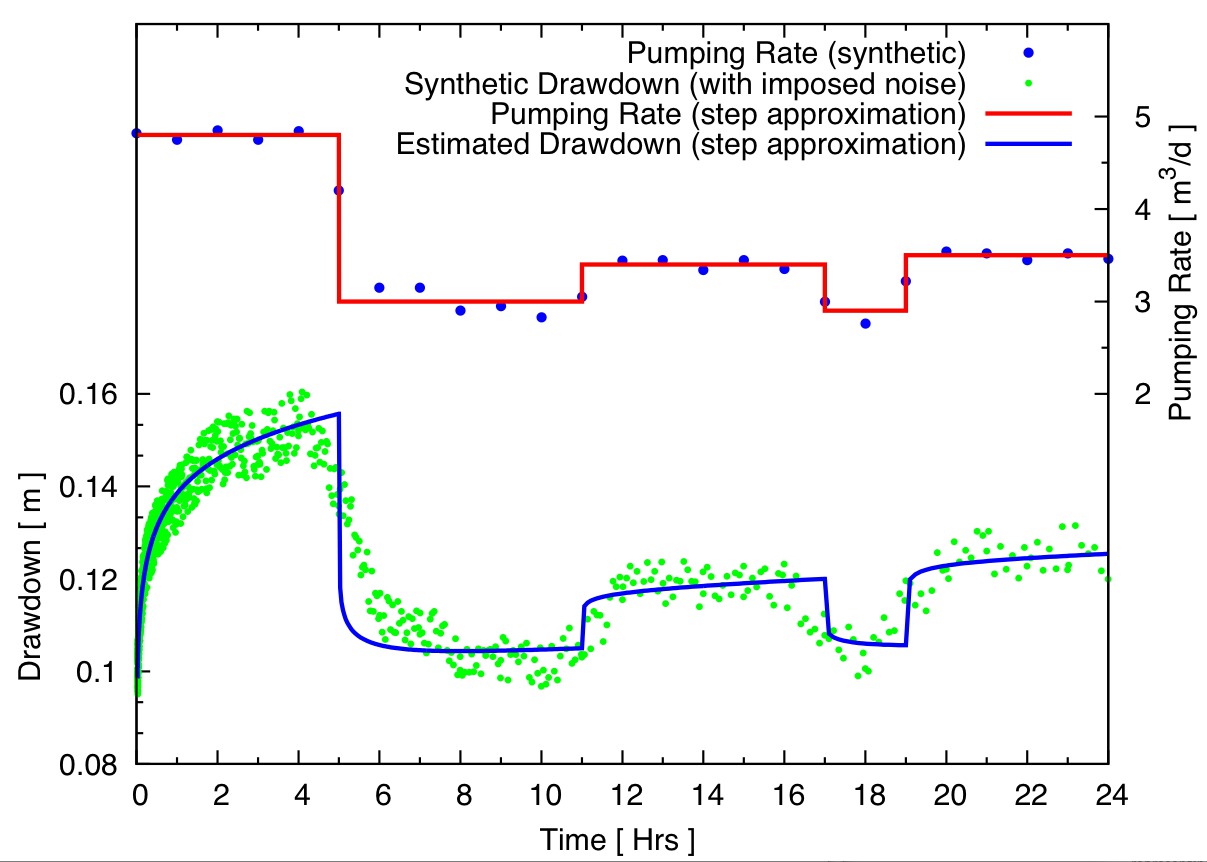Applications
WELLS has been applied to the following studies (click on figures to enlarge).
Identification of Pumping Influences in Long-Term Water Level Fluctuations (Harp and Vesselinov, 2011)
Abstract: Identification of the pumping influences at monitoring wells caused by spatially and temporally variable water supply pumping can be a challenging, yet an important hydrogeological task. The information that can be obtained can be critical for conceptualization of the hydrogeological conditions and indications of the zone of influence of the individual pumping wells. However, the pumping influences are often intermittent and small in magnitude with variable production rates from multiple pumping wells. While these difficulties may support an inclination to abandon the existing dataset and conduct a dedicated cross-hole pumping test, that option can be challenging and expensive to coordinate and execute. This paper presents a method that utilizes a simple analytical modeling approach for analysis of a long-term water level record utilizing an inverse modeling approach. The methodology allows the identification of pumping wells influencing the water level fluctuations. Thus, the analysis provides an efficient and cost-effective alternative to designed and coordinated cross-hole pumping tests. We apply this method on a dataset from the Los Alamos National Laboratory site. Our analysis also provides (1) an evaluation of the information content of the transient water level data; (2) indications of potential structures of the aquifer heterogeneity inhibiting or promoting pressure propagation; and (3) guidance for the development of more complicated models requiring detailed specification of the aquifer heterogeneity
Accounting for the influence of aquifer heterogeneity on spatial propagation of pumping drawdown (Harp and Vesselinov, 2011)
Abstract: It has been previously observed that during a pumping test in heterogeneous media, drawdown data from different time periods collected at a single location produce different estimates of aquifer properties and that Theis type-curve inferences are more variable than late-time Cooper-Jacob inferences. In order to obtain estimates of aquifer properties from highly transient drawdown data using the Theis solution, it is necessary to account for this behavior. We present an approach that utilizes an exponential functional form to represent Theis parameter behavior resulting from the spatial propagation of a cone of depression. This approach allows the use of transient data consisting of early-time drawdown data to obtain late-time convergent Theis parameters consistent with Cooper-Jacob method inferences. We demonstrate the approach on a multi-year dataset consisting of multi-well transient water-level observations due to transient multi-well water-supply pumping. Based on previous research, transmissivities associated with each of the pumping wells are required to converge to a single value, while storativities are allowed to converge to distinct values.
On simulation and analysis of variable-rate pumping tests (Mishra et al., 2011)
Abstract: Analytical solutions for constant-rate pumping tests are widely used to infer aquifer properties. The aquifer parameters are estimated by fitting pressure responses observed during pumping test to appropriate analytical solutions for radial flow towards the pumping well. For mathematical simplicity, analytical solutions are commonly derived for constant- rate pumping conditions. However, the pumping rate is often varied either intentionally or due to technical difficulties during the test. Using the principle of superposition, the constant-rate analytical solutions are frequently applied to analyze pumping tests conducted with variable pumping rates by representing pumping rate variation as a series of steps of constant-pumping rate changes. In this study, we propose a methodology that approximates the time-varying pumping record as a series of segments with linearly varying pumping rates.The proposed approach is demonstrated using an analytical solution due to Hantush (1964) for confined aquifers. However, the proposed approach is also applicable to unconfined and/or leaky aquifers. We validate our approach by comparing it with sinusoidally varying pumping tests having direct analytical solution. We also apply our methodology to analyze the synthetic pumping test data by inversely estimating the apparent aquifer parameters and compare it with commonly used method where pumping rate variations are represented by series of constant rate step changes.
References
Download
The WELLS code is available at no cost. Please follow the instructions on "Download" page.
Question/Comments
For questions/comments please fill out the information on the contact us page.




